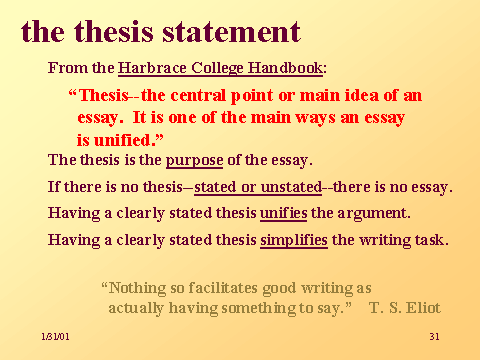 How
to Write Thesis
Statements
How
to Write Thesis
Statements
 How
to Write Thesis
Statements
How
to Write Thesis
Statements

A. Any thesis statement must first of all be S.O.D:

Specific,
Opinionated, and
Deniable.
B. A good thesis statement limits the scope of the subject to the length, purpose and audience of the paper. Be as specific as possible. Your thesis must be narrow enough that your topic can be discussed fully in the space available.

C. A thesis statement is not a topic sentence, a title or a summary; rather, you must make a deniable assertion. That is, you are proposing an idea that someone else might not share.
D. A thesis must be unified; that is, it expresses only one idea (that is to say, you do not want to write about both the age and the composition of the moon unless you can find a way to connect the two logically into one coherent idea—the fact that they both have to do with the moon is too weak a connection).
E. Any thesis statement must be intended for a specific audience. A thesis statement written for no specific audience (or for a "universal audience," which is the same thing) is a bad thesis statement.
F. A good thesis statement is never:
a title (
"The Civil War in Uganda."),an announcement ("
In this paper I will discuss the war in Uganda."),an unquestioned fact (
"Uganda is located in East Africa."),or an unanswered question (
"What can we do to help out the innocent victims of the terrible civil war in Uganda?").
 G. The biggest error most beginning scholarly
writers commit is to create a thesis statement that is too broad (and would take
a large book--or an entire career--to write about). Their greatest fear is
narrowing their subject too much and not having enough to write on. This is
wrong, however.
G. The biggest error most beginning scholarly
writers commit is to create a thesis statement that is too broad (and would take
a large book--or an entire career--to write about). Their greatest fear is
narrowing their subject too much and not having enough to write on. This is
wrong, however.
H. Your purpose in scholarly writing is normally not to write a general introduction "for dummies" to a broad field of knowledge (e.g., smoking, health care, astronomy, auto maintenance). Nor is it just to prove you read the assignment or did the research, either. Rather, it is to for you to do an intensely focused, in-depth study of one tiny bit of knowledge, where you learn just about everything there is to know about the question and become the expert on that tiny subject. Then you write the paper as an expert writing to other experts.

I. In most forms of scholarly writing your text begins with a hard-hitting thesis statement. In some others, the thesis statement is placed at the end of the introduction. Ask your professor which is right for your particular writing situation and for your specific audience.
O.W. Rev 07/06
| For educational purposes only. |
| Owen M. Williamson - Education Bldg 211E - phone: (915) 747 7625 - fax: (915) 747 5655 |
| The University of Texas at El Paso - 500 W. University Ave. - El Paso, TX 79968 |
| Important Disclaimer |

Open Courseware | OCW |This work is dedicated to the Public Domain..